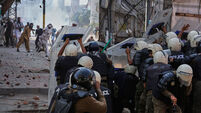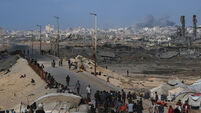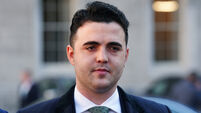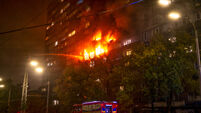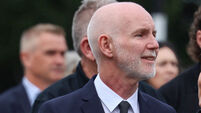Hamas and Israel prepare to implement ceasefire as Netanyahu says deal approved by government
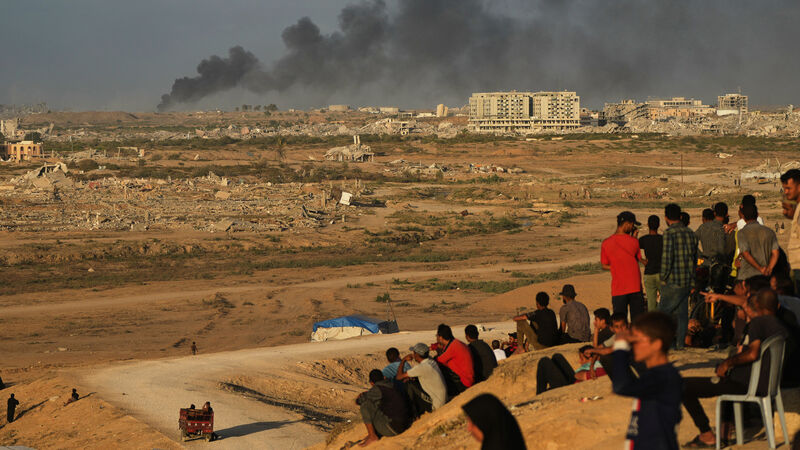
Displaced Palestinians watch smoke rise after Israeli military strikes as they gather on the coastal road near Wadi Gaza. Picture: Abdel Kareem Hana/AP
Israelis and Palestinians celebrated on Thursday night as Hamas and Israel’s government began preparations to implement a ceasefire deal that promises a durable end to a bloody two-year conflict that has killed tens of thousands, destabilised much of the Middle East and prompted protests around the world.
In Gaza, there was joy but much anxiety. Many expressed the fear that the new deal would collapse, bringing more suffering to the devastated territory. Though crowds gathered in some places to dance and sing, in many places witnesses reported muted reaction amid loud overflights by warplanes and drones.
In Israel, on a day of fast-moving and sometimes chaotic developments, hospitals readied to receive hostages to be released by Hamas, the ruling coalition government signed off on the new ceasefire deal and thousands took to the streets of Tel Aviv to express joy and relief.
Late on Thursday evening, a statement from the government said it had “just approved the framework for the release of all the hostages – both the living and the deceased”.
Donald Trump’s announcement of his “peace proposal” last week triggered a frantic round of indirect negotiations between Hamas and Israel in the Egyptian Red Sea resort of Sharm-el Sheikh.
The US president said on Thursday he would try to go to Egypt for the signing of the new deal. In Israel, officials suggested that the US president was expected to visit there on Sunday.
Trump added that 48 hostages held by Hamas, of whom less than half are thought to be still alive, would be released on “Monday or Tuesday” and said that the deal had “ended the war in Gaza”.
With the approval of the first phase of the plan, all our hostages will be brought home. This is a diplomatic success and a national and moral victory for the State of Israel.
— Benjamin Netanyahu - בנימין נתניהו (@netanyahu) October 8, 2025
From the beginning, I made it clear: we will not rest until all our hostages return and all our goals…
It was announced on Thursday night that the US would send about 200 troops to Israel to help support and monitor Gaza ceasefire deal.
World leaders scrambled to welcome the breakthrough, even if most of Trump’s broader “peace proposal” has yet to be negotiated or even explicitly acknowledged by Hamas and Israel. The US president told reporters in the Oval Office that nobody would be forced to leave Gaza under the terms of the deal. “No, it’s just the opposite,” he said. “This is a great plan.”
There was some confusion during Thursday on the timing of the first phase of the deal – reflecting the general uncertainty about many of its main principles.
The office of Israel’s prime minister, Benjamin Netanyahu, said the ceasefire would take effect once the agreement was ratified by his government. But an Israeli government spokesperson said the ceasefire would go into force within 24 hours of the cabinet meeting. Those hostages believed to still be alive in Gaza would then be freed within 72 hours, they said.
Israel’s forces would withdraw to an agreed line in the Gaza Strip that would leave them in control of 53% of the territory, a spokesperson for the Israeli government said.
In exchange, Israel will free about 2,000 Palestinian prisoners, but the spokesperson said Marwan Barghouti, a senior figure in Mahmoud Abbas’s Fatah movement who is hugely popular in the West Bank and Gaza and has frequently been talked of as a future leader, would not be among them. Hamas sources said the list of released prisoners was still being discussed late on Thursday.
Hamas called on Trump and guarantor states to ensure Israel fully implemented the ceasefire.
The exiled Gaza chief Khalil Al-Hayya said on Thursday the group has received guarantees from the United States, Arab mediators and Turkey that the war on Gaza has permanently ended, according to Reuters.
UN agencies said they were ready to rush aid into Gaza, where a famine was declared by experts in August.
António Guterres, the UN secretary-general, said “to turn this ceasefire into real progress, we need more than the silencing of the guns”.
Guterres called for safe access for humanitarian workers, the removal of bureaucratic obstacles to swift delivery of aid, the rebuilding of Gaza’s shattered infrastructure and funding to meet the immense needs.
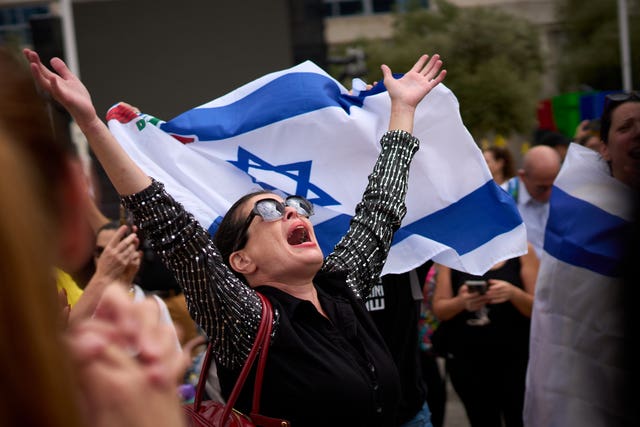
In Israel, thousands of people filled a square in Tel Aviv that has become a focus of the campaign to bring home the hostages. Many sang and danced as they waved Israeli and American flags.
“It feels like we can finally see a bit of light at the end of the tunnel we have all been walking through,” said Einav Kahila, a 25-year-old student who travelled from Jerusalem. “There’s a lot of anxiety, also, because we’re always feeling unsure or insecure about the situation. But the people that came here today chose to be on the side of optimism.”
Einav Zaugauker rejoiced at the prospect of freedom for her son Matan, one of the last hostages.
“I can’t breathe, I can’t breathe, I can’t explain what I’m feeling … it’s crazy,” she said.
In Gaza, Ola Al-Nazli, 47, said she had learned of the ceasefire from her neighbours in al-Muwasi, a crowded and squalid coastal strip where hundreds of thousands of Palestinians displaced by successive Israeli offensives have sought shelter.
“I did not know how to feel, whether to be happy or sad. We have experienced this many times before, and each time we were disappointed again, so this time fear and caution are stronger than ever,” said al Nazli, who was forced to leave her home in Gaza City by the recent Israeli offensive there.
“Everyone lives in tents that do not protect from the cold or from the bombing. Those who had money or work lost everything. That is why our happiness is incomplete, mixed with pain … I only hope that we can live in safety, not hear the sound of bombs again, not be forced to move from one place to another, and that the crossings [into Gaza from Israel] will open soon.”
Successful completion of the deal would mark the biggest foreign policy achievement so far for Trump, who took office in January promising to quickly end the wars in Gaza and Ukraine, only to be confronted with obstacles and complexities he had apparently not foreseen.
Senior envoys from the US, Qatar and Turkey had joined the talks in the Egyptian Red Sea resort of Sharm-el-Sheikh this week, apparently adding momentum to discussions launched on Monday. Trump sent his son-in-law Jared Kushner and the special envoy Steve Witkoff. Both were reported to have arrived in Israel on Thursday night.
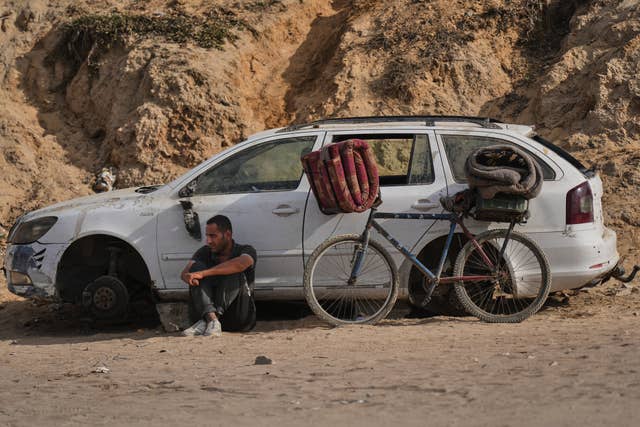
Negotiators have closed gaps between Hamas and Israel over the details of the first phase of the 20-point plan announced by Trump, but it is unclear whether the parties had even discussed thornier questions, such as how Hamas will be disarmed, as Israel has demanded, and the eventual governance of Gaza.
Senior Hamas official Osama Hamdan on Thursday told Qatar-based broadcaster Al Araby the Palestinian militant group rejects Trump’s proposal for an interim “Board of Peace” to oversee Gaza’s administration, headed by the US president himself.
Though huge challenges remain, the agreement nonetheless brings the two sides closer than any previous effort to halt a war that evolved into a regional conflict, drawing in countries such as Iran, Yemen and Lebanon, and reshaping the Middle East.
In recent days, Israel reduced the intensity of its military campaign. Gaza medical authorities reported eight people were killed in Israeli strikes on Wednesday. Even if aid surges in, through the UN and the Red Crescent as specified under Trump’s plan, hundreds of thousands will still not have enough food or shelter.
About 1,200, mostly civilians, were killed in the Hamas attacks of October 2023 and 251 taken hostage. Israel’s retaliatory offensive has killed more than 67,000, mostly civilians, and reduced much of Gaza to rubble.




